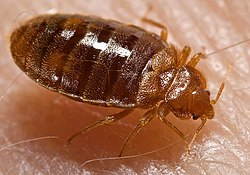Vägglöss
| Vägglöss | |
 Vägglus (Cimex lectularius) | |
| Systematik | |
|---|---|
| Domän | Eukaryoter Eukaryota |
| Rike | Djur Animalia |
| Stam | Leddjur Arthropoda |
| Understam | Sexfotingar Hexapoda |
| Klass | Insekter Insecta |
| Ordning | Halvvingar Hemiptera |
| Underordning | Skinnbaggar Heteroptera |
| Familj | Vägglöss Cimicidae |
| Vetenskapligt namn | |
| § Cimicidae | |
| Auktor | Latreille, 1802 |
| Hitta fler artiklar om djur med | |
Vägglöss (Cimicidae) är en familj insekter bland skinnbaggarna. Familjen har cirka 75 arter, varav 4 finns i Sverige. De lever som blodsugande parasiter på däggdjur och fåglar.
Egenskaper
Vägglöss är breda, plattade skinnbaggar med reducerade vingar och ektoparsitiskt levnadssätt.[1] Längden är mellan 2,5 och 12 millimeter. På människan lever arten vägglus (Cimex lectularius).
I folkmun även pankor och väggmadammer.[2]
Arter i Sverige
- Cimex dissimilis
- Vägglus (Cimex lectularius)
- Cimex pipistrelli
- Svalans vägglus (Oeciacus hirundinis)
Referenser
- ^ Bra Böckers lexikon, 1980.
- ^ Skarback, Sören (1997). Göteborg: 777 frågor & svar. Göteborg: Tre böcker. sid. 229. Libris 7592994. ISBN 91-7029-335-X
Externa länkar
 Wikimedia Commons har media som rör vägglöss.
Wikimedia Commons har media som rör vägglöss.
Media som används på denna webbplats
ID#: 9822
This 2006 photograph depicted an oblique-dorsal view of a bed bug nymph (Cimex lectularius) as it was in the process of ingesting a blood meal from the arm of a “voluntary” human host.
Bed bugs are not vectors in nature of any known human disease. Although some disease organisms have been recovered from bed bugs under laboratory conditions, none have been shown to be transmitted by bed bugs outside of the laboratory.
The common bed bug is found worldwide. Infestations are common in the developing world, occurring in settings of unsanitary living conditions and severe crowding. In North America and Western Europe, bed bug infestations became rare during the second half of the 20th century and have been viewed as a condition that occurs in travelers returning from developing countries. However, anecdotal reports suggest that bed bugs are increasingly common in the United States, Canada, and the United Kingdom.
C. lectularius inject saliva into the blood stream of their host to thin the blood, and to prevent coagulation. It is this saliva that causes the intense itching and welts. The delay in the onset of itching gives the feeding bed bug time to escape into cracks and crevices. In some cases, the itchy bites can develop into painful welts that last several days.
Bed bug bites are difficult to diagnose due to the variability in bite response between people, and due to the change in skin reaction for the same person over time. It is best to collect and identify bed bugs to confirm bites. Bed bugs are responsible for loss of sleep, discomfort, disfiguring from numerous bites and occasionally bites may become infected.